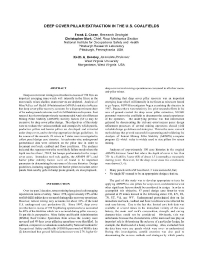 |
Deep cover retreat mining (overburden in excess of 750 ft) is an important emerging issue which will intensify in the future as the more easily mined shallow seam reserves are depleted. Analysis of Mine Safety and Health Administration (MSHA) statistics indicates that deep cover pillar recovery accounts for a disproportionate share of the underground coal mine roof/rib fall fatalities and injuries. Past research has shown that previously recommended Analysis of Retreat Mining Pillar Stability (ARMPS) stability factors (SF's) may be excessive for deep cover pillar design. The objectives of this study were to evaluate the various methods and strategies by which panels, production pillars and barrier pillars are developed and extracted under deep cover, and to develop appropriate design guidelines. In the course of the research, 29 mines in 7 states were investigated to collect panel design case histories. At each mine site, underground geotechnical data were collected on the pillar line in order to document roof rock, coalbed and floor conditions. The analyses indicated that squeezes were the most likely failure mode where the depth was less than 1,250 ft, but bumps predominated in the deeper cover cases. Immediate roof rock quality, the ARMPS SF's, and barrier pillar stability factors were all found to be important parameters in determining the outcomes of the case histories. Design guidelines, including suggestions for barrier pillars to isolate active panels from nearby gobs in bump prone ground, are also proposed.
| Author(s): | Chase-FE, Mark-C, Heasley-KA |
| Reference: | In: Peng SS, Mark C, Khair AW, Heasley KA, eds. Proceedings of the 21st International Conference on Ground Control in Mining. Morgantown, WV: West Virginia University, 2002 Aug; :68-80 |
dcpei (PDF, 655 KB)